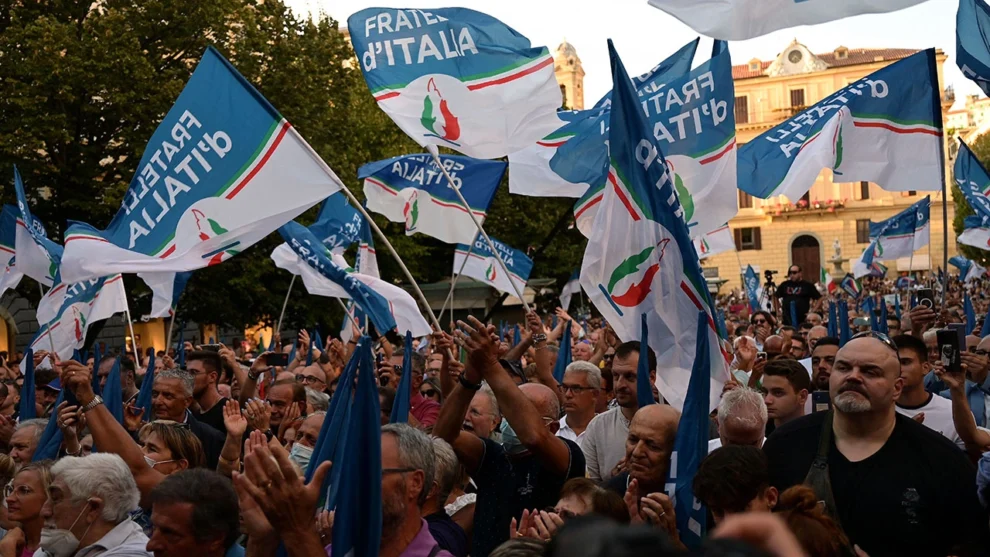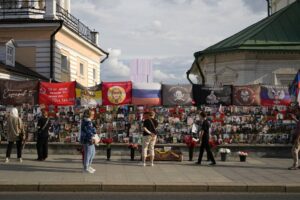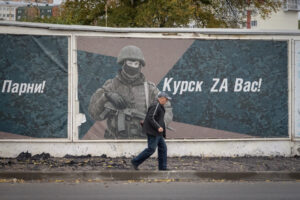NATO continues to thwart and confront Russia’s aggression in Ukraine through sanctions, political pressure, arms supplies, and economic support for Kyiv. Moscow’s direct response outside the battlefield, however, has been relatively limited beyond rhetoric and increasingly strident statements and actions on the international stage. But Moscow clearly sees Europe as the soft underbelly of the alliance and has increasingly used soft and hard measures to try to create friction and strike back. One key vector that Moscow might exploit is the far and extreme right in Europe, which has often tended in a pro-Russian direction.
Any Russian action in support of these groups is unlikely to be obvious. A hint of what might be coming may be visible in a series of letter bombs in Spain late last year; the New York Times reported that U.S. intelligence initially linked the attacks to a Russian intelligence effort that was working with extreme right-wing actors, but the bombs were ultimately traced to a lone individual who was inspired in part by Russian propaganda. Other traces could be found in the group of German “sovereign citizens” or “Reichsbürgers,” who were planning to overthrow the government before their arrest in December 2022. At least one of the suspects in the case was linked to the far-right Alternative for Germany (AfD) political party, and the group had sought to make contact with Russian authorities to solicit help stabilizing their government once they had taken over. Moscow has long cultivated links with different parts of Europe’s right wing, from mainstream politicians to proscribed terrorists. Given existing social tensions in Europe, this provides an ideal space for Russian meddling.
Russia’s Ties to the European Far Right
Russia already has a means to act on these threats. The Russian Imperial Movement (RIM) is an international far-right group, which was listed as a specially designated terrorist organization by the United States in April 2020. The U.S. policy was “the first time in history” that the U.S. government had “designated a white supremacist group,” as then-Secretary of State Mike Pompeo pointed out at the time. Subsequent reporting highlighted how the group had provided training centers in St. Petersburg for Swedish, German, Slovakian, Finnish, and Danish right-wing radicals. One of the Swedes, Anton Thulin, was a member of the Nordic Resistance Movement and was jailed for bombing a refugee center in Gothenburg in 2017. That attack was one of three carried out by his cell; others targeted a Swedish left-wing organization and another refugee center. Upon his release, Thulin went to Poland where he sought additional training. RIM leader Stanislav Vorobyov has been linked to extreme-right groups across Europe. Other RIM members have trained and gone to fight in Ukraine in support of the Russian offensive. But the problem of far-right Russian sympathizers joining the fight goes well beyond just RIM—numerous Italian, French, and other European extremists have also elected to go and fight alongside Russian-supporting groups in Ukraine.
RIM is not the only strand of the terrorist extreme right that has ties to St. Petersburg. Shortly before RIM’s designation, investigations by the Guardian and the BBC uncovered that The Base, an international neo-Nazi accelerationist group, was being run from St. Petersburg by an American, Rinaldo Nazzaro, through a web of online platforms and encrypted applications used for recruitment and incitement. Nazzaro is accused of building networks of angry white men and instigating racially motivated attacks from his home in Russia. He has also appeared a few times in the Russian media from his new home (where he says he moved with his Russian wife in 2018 so that his child would not “grow up in the USA because I felt like it was too degenerate”) to criticize the West. While most of The Base’s targets seem to be in the United States, and U.S. members have been prosecuted, the group is also proscribed in the United Kingdom, Australia, and New Zealand. In the U.K., it has been linked to the recruitment of teenagers to extremist networks. Nazarro has declared that he has stepped back from The Base, but his online posting still highlights his support for the group’s ideas.
Russia’s connection to the German Reichsbürger plot is weaker but present. In that case, it appears that one of the plotters was previously a member of the far-right AfD political party directly involved in the support the party received from Moscow. Members of the network are accused of seeking direct links with Russia to gain support (the Kremlin denied playing any role). In another recent example, the AfD appears to have played a role in Russia’s recruitment of a senior German intelligence officer, who supplied Russia with information about the war in Ukraine.
The AfD links shows how other, less overtly violent parts of the far right also have ties to Russia. Britain First—a far-right group in the United Kingdom that has published material later found with individuals involved in violent attacks, and that was briefly promoted on Twitter by President Trump—has long been suspected of receiving support from Russia. Its leader, Paul Golding, has made at least three visits to Russia, spoken in the Duma, and praised President Vladimir Putin’s Russia on Russian television. U.K. police have investigated his financial affairs on the suspicion that he has been receiving money from sources in Moscow, and charged and convicted him for refusing to cooperate with an investigation after returning from a trip to Russia. Many other mainstream far-right politicians in Europe have also cultivated relations with Russia.
An Unpopular Time to Be Pro-Russia
Russia’s war in Ukraine has somewhat dulled the influence of these mainstream pro-Putin politicians—given the negative overall view of what Russia is doing in Europe, it’s harder to maintain public support while voicing support for Russia. Italy’s current government coalition includes leaders who have spoken openly of their support for Putin, but Prime Minister Giorgia Meloni made it a point to highlight her country’s support for Ukraine, and Matteo Salvini (who infamously wore a pro-Putin T-shirt in parliament) canceled a visit to Moscow that he had planned in June 2022, though he has also said that he thinks sanctions targeting Russia will damage Italy. At the extreme, Nazzaro has told supporters to steer clear of the war in Ukraine, which he sees as a pointless “NATO proxy war,” and Britain First has called for peace in the conflict on its Telegram channel but continued to support Russia.
The political winds in Europe are blowing against Russia and its supporters at the moment. But among the violent fringe, sympathetic groups and individuals still provide Putin a tool to destabilize Europe; some of these extremists are receiving military training and experience on the battlefield in Ukraine.
Russia has a long history of violently targeting opponents in Europe. From shooting Chechens in the streets of Berlin and Istanbul, to poisoning defected intelligence agents in the United Kingdom, to the dramatic deaths of various prominent Russian businessmen across Europe over the span of decades, Moscow’s enemies in Europe often fall prey to violent incidents. In addition, through its intelligence agencies, the Kremlin has worked to destabilize governments, meddle in public discourse and elections, and generally stir trouble wherever it can. In 2017, British intelligence reported a plot stirred by Russian agents to overthrow the government in Montenegro, and shortly before the Russian invasion, they pointed to a plot to install a puppet regime in Kyiv. More recently, Moldovan authorities released documents that appear to lay out Russia’s playbook for destabilizing their country and arrested Russian agents linked to the Wagner Group reportedly entering the country to carry out the plot.
Beyond Europe, Russia has attempted to spread its influence through other means, particularly using counterterrorism cooperation as a tool of engagement and influence. Russia has used arms sales and Wagner Group operations to supplant French influence and cultivate a reputation as a willing partner across Africa. It is now deploying a similar approach in Myanmar, where a long-standing defense relationship has now blossomed into bilateral engagement focused on counterterrorism as the military regime in Naypyidaw continues to attempt to put down resistance to its February 2021 coup. Russia has not hesitated to weaponize counterterrorism rhetoric and policies around the world as a tool for international engagement and to undermine Western influence.
But it is in Europe where Russia is likely to have the most impact fostering threats, in large part because its efforts in Europe build on existing fissures in society. For almost a decade, there has been a political crisis in Europe over immigration and fears of violent Islamist terrorism, which has stirred concern and paranoia among a growing number of people. This situation has led people to radicalize, some in mainstream politics where a growing number of parties focused on such issues have come to prominence, but also through growing extreme far-right and white supremacist groups on the fringes of European politics. Russia has exploited other political faultlines in Europe as well, interfering in the Brexit referendum in the United Kingdom, the Catalan separatist movement, and German, French, and Dutch elections.
Creating a Climate of Confusion
In some cases, the degree to which threats in Europe are being directed by Russia may be overstated. For example, British Islamist Anjem Choudary’s appearance on Russian platform VKontakte (a Facebook equivalent) could be ascribed to Moscow’s meddling, or it could just be a pragmatic choice by someone shunned on most other platforms to take advantage of VK’s lack of interest. It is possible to find links to Russia across a wide range of threats and problems, but not all of these are necessarily part of a wider plot.
It is also the case that the extreme right has ties to both sides of the battlefield in Ukraine. While it is clear that Russia is using some of these groups to support its cause, there are others that fight on the Ukrainian side. A recent cross-border incursion into Russia was undertaken by the Russian Volunteer Corps, a group led by a man who has unabashedly trumpeted his extreme right-wing views. And prior to the invasion, there was a steady trickle of men linked to extreme right-wing groups traveling to join the Ukrainian Azov battalion, which is associated with Nazi iconography and hardline nationalist beliefs.
This is a muddled state of affairs. Russian ties to extremists are often present, but not every instance of smoke indicates fire. The politics of the moment are defined by the war in Ukraine, but far-right extremists have divided sympathies. Despite this confusion, Europe has thus far proved durable as a Ukrainian ally, suggesting that any efforts by Russia to foster extremism and pro-Russian attitudes has not had much effect overall. European intelligence has stepped up its efforts at countering Russian penetration, and overt political support for Russia is not as appealing as it was prior to the invasion. The clientele of Russia’s influence operations are a fickle group of opportunists.
But this confusion is also a key part of Moscow’s playbook for asymmetric warfare. While Russia appears to have very few limits on what it will do and what tools it might deploy, its actions are not always linked to a specific goal. For the Kremlin, stirring trouble and creating confusion is often a good result in itself. But meddling with the extreme right and inciting terrorist groups creates problems that could be difficult for Russia to control. There is of course considerable irony in Russia trying to manipulate the far right in the midst of a war in which it claims to be fighting fascists. But Moscow is nothing if not flexible when it comes to fighting its wars and seeing who it can use to advance its cause.
Source : LAWFARE

































